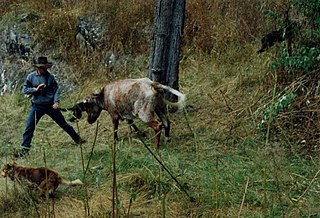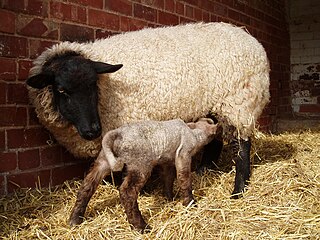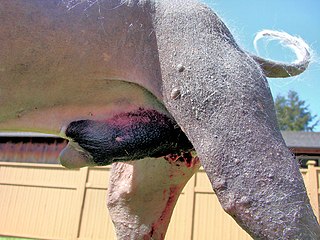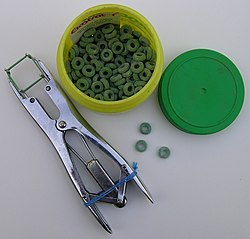
Castration is any action, surgical, chemical, or otherwise, by which a male loses use of the testicles: the male gonad. Surgical castration is bilateral orchiectomy, while chemical castration uses pharmaceutical drugs to deactivate the testes. Castration causes sterilization ; it also greatly reduces the production of hormones, such as testosterone and estrogen. Surgical castration in animals is often called neutering.

Animal husbandry is the branch of agriculture concerned with animals that are raised for meat, fibre, milk, or other products. It includes day-to-day care, management, production, nutrition, selective breeding, and the raising of livestock. Husbandry has a long history, starting with the Neolithic Revolution when animals were first domesticated, from around 13,000 BC onwards, predating farming of the first crops. During the period of ancient societies like ancient Egypt, cattle, sheep, goats, and pigs were being raised on farms.

A gelding is a castrated male horse or other equine, such as a pony, donkey or a mule. The term is also used with certain other animals and livestock, such as domesticated camels. By comparison, the equivalent term for castrated male cattle would be steer, and wether for sheep and goats.

Cryptorchidism, also known as undescended testis, is the failure of one or both testes to descend into the scrotum. The word is from Ancient Greek κρυπτός (kryptos) 'hidden' and ὄρχις (orchis) 'testicle'. It is the most common birth defect of the male genital tract. About 3% of full-term and 30% of premature infant boys are born with at least one undescended testis. However, about 80% of cryptorchid testes descend by the first year of life, making the true incidence of cryptorchidism around 1% overall. Cryptorchidism may develop after infancy, sometimes as late as young adulthood, but that is exceptional.

Rocky Mountain oysters or mountain oysters, or meat balls, also known as prairie oysters in Canada, is a dish made of bull testicles. The organs are often deep-fried after being skinned, coated in flour, pepper and salt, and sometimes pounded flat. The dish is most often served as an appetizer.

Orchiopexy is a surgery to move and/or permanently fix a testicle into the scrotum. While orchiopexy typically describes the operation to surgically correct an undescended testicle, it is also used to resolve testicular torsion.

Sheep farming or sheep husbandry is the raising and breeding of domestic sheep. It is a branch of animal husbandry. Sheep are raised principally for their meat, milk, and fiber (wool). They also yield sheepskin and parchment.

The Burdizzo is the name brand of a company that makes a castration device which employs a large clamp designed to break the blood vessels leading into the testicles. Once the blood supply to the testicles is lost, testicular necrosis occurs, and the testicles shrink, soften, and eventually deteriorate completely. When the device is used, the operator crushes the spermatic cords one at a time, leaving a space in between in order to prevent an interruption of blood-flow to the scrotum.
Banding is a medical procedure which uses elastic bands for constriction. Banding may be used to tie off blood vessels in order to stop bleeding, as in the treatment of bleeding esophageal varices. The band restricts blood flow to the ligated tissue, so that it eventually dies and sloughs away from the supporting tissue. This same principle underlies banding as treatment for hemorrhoids.

The testicles of calves, lambs, roosters, turkeys, and other animals are eaten in many parts of the world, often under euphemistic culinary names. Testicles are a by-product of the castration of young animals raised for meat, so they were originally a late-spring seasonal specialty, though nowadays they are generally available year-round.

Veterinary surgery is surgery performed on non-human animals by veterinarians, whereby the procedures fall into three broad categories: orthopaedics, soft tissue surgery, and neurosurgery. Advanced surgical procedures such as joint replacement, fracture repair, stabilization of cranial cruciate ligament deficiency, oncologic (cancer) surgery, herniated disc treatment, complicated gastrointestinal or urogenital procedures, kidney transplant, skin grafts, complicated wound management, and minimally invasive procedures are performed by veterinary surgeons. Most general practice veterinarians perform routine surgeries such as neuters and minor mass excisions; some also perform additional procedures.

A muster (Au/NZ) or a roundup (US/Ca) is the process of gathering livestock. Musters usually involve cattle, sheep or horses, but may also include goats, camels, buffalo or other animals. Mustering may be conducted for a variety of reasons including routine livestock health checks and treatments, branding, shearing, lamb marking, sale, feeding and transport or droving to another location. Mustering is a long, difficult and sometimes dangerous job, especially on the vast Australian cattle stations of the Top End, 'The Falls' (gorge) country of the Great Dividing Range and the ranches of the western United States. The group of animals gathered in a muster is referred to as a "mob" in Australia and a "herd" in North America.

Polled livestock are livestock without horns in species which are normally horned. The term refers to both breeds and strains that are naturally polled through selective breeding and also to naturally horned animals that have been disbudded. Natural polling occurs in cattle, yaks, water buffalo, and goats, and in these animals it affects both sexes equally; in sheep, by contrast, both sexes may be horned, both polled, or only the females polled. The history of breeding polled livestock starts about 6000 years BC.
Docking is the intentional removal of part of an animal's tail or, sometimes, ears. The term cropping is more commonly used in reference to the cropping of ears, while docking more commonly—but not exclusively—refers to the tail; the term tailing is used, also. The term has its origins in the living flesh of the tail, commonly known as the dock, from which the animal's tail hairs grow.

Dehorning is the process of removing the horns of livestock. Cattle, sheep, and goats are sometimes dehorned for economic and safety reasons. Disbudding is a different process with similar results; it cauterizes and thus destroys horn buds before they have grown into horns. Disbudding is commonly performed early in an animal's life, as are other procedures such as docking and castration. In some cases, it can be unnecessary.

The raising of domestic sheep has occurred in nearly every inhabited part of the earth, and the variations in cultures and languages which have kept sheep has produced a vast lexicon of unique terminology used to describe sheep husbandry.

Domesticated sheep are herd animals that are bred for agricultural trade. A flock of sheep is mated by a single ram, which has either been chosen by a farmer or, in feral populations, has established dominance through physical contests with other rams. Sheep have a breeding season (tupping) in the autumn, though some can breed year-round.

Sheep or domestic sheep are a domesticated, ruminant mammal typically kept as livestock. Although the term sheep can apply to other species in the genus Ovis, in everyday usage it almost always refers to domesticated sheep. Like all ruminants, sheep are members of the order Artiodactyla, the even-toed ungulates. Numbering a little over one billion, domestic sheep are also the most numerous species of sheep. An adult female is referred to as a ewe, an intact male as a ram, occasionally a tup, a castrated male as a wether, and a young sheep as a lamb.

Urethrostomy is a surgical procedure that creates a permanent opening in the urethra, commonly to remove obstructions to urine flow. The procedure is most often performed in male cats, where the opening is made in the perineum.

A bull is an intact adult male of the species Bos taurus (cattle). More muscular and aggressive than the females of the same species, bulls have long been an important symbol in many religions, including for sacrifices. These animals play a significant role in beef ranching, dairy farming, and a variety of sporting and cultural activities, including bullfighting and bull riding.




















